I have an enduring penchant for soup and Potato Leek has always been one of my favorites. While not the most figure-friendly option, it’s delightfully hearty and warming, the perfect comfort on a chilly Winter day like we’ve been experiencing lately in South Florida – seriously, it really HAS been cold! I recently came across this recipe for Celery Leek... Read More
The post Which Wines to Pair With: Celery Leek Soup with Bacon & Croutons! appeared first on The Glamorous Gourmet.
I have an enduring penchant for soup and Potato Leek has always been one of my favorites. While not the most figure-friendly option, it’s delightfully hearty and warming, the perfect comfort on a chilly Winter day like we’ve been experiencing lately in South Florida – seriously, it really HAS been cold!
I recently came across this recipe for Celery Leek Soup with Bacon & Croutons which sounded very similar except it didn’t call for the starchy potatoes or heavy cream found in most Potato Leek Soup recipes – well, the good ones anyway. The Celery Leek Soup recipe swapped the potatoes for celery and the heavy cream was replaced with a scant 1/2 cup of crème fraîche. My husband had also been on a celery kick lately and whether slathered with peanut butter or accompanied by a Bloody Mary he couldn’t get enough of it! It seemed like the perfect time to give this recipe a try but could celery possibly make an adequate substitute for potatoes? There was only one way to find out.
I must admit, halfway through the recipe I was a little doubtful. As the veggies cooked down it didn’t seem like the celery was going to cut it as a replacement for rich, creamy Yukon Golds. I forged on, however, and I’m so glad I did! The Soup Gods were definitely smiling on me that day – this celery-based soup was creamy, flavorful, and delicious! The puree of celery, leeks, onions, and garlic is deliciously enhanced by the addition of crème fraîche and then studded with smoky, crunchy bits of bacon and croutons – what’s not to love about that? A few tips though, be sure to season the soup generously with salt and pepper, sampling often to adjust to your taste. Feel free to puree the soup to your desired level of consistency. If you prefer it super silky, strain it through a sieve after you puree it, we enjoyed the soup with some texture though.
To pair with the Celery Leek Soup with Bacon & Croutons I recommend the 2009 Pillar Box White ($16) from Padthaway, Australia. This blend of Sauvignon Blanc, Verdelho, and Chardonnay has delightful notes of pear and tangy citrus with a food friendly acidity that pairs so nicely with the soup. If you’re more of a red wine person, the 2011 Paul Cluver Pinot Noir ($20) from South Africa will also pair nicely, highlighting the smoky bacon aspect of the dish. I hope you enjoy this pairing as much as we did – I’d love to hear what you think!
Cheers,
“Celery Leek Soup with Bacon & Croutons”
Adapted from Food & Wine Magazine, January 2015
6 tablespoons butter
3 medium leeks, halved & thinly sliced
2 medium onions, finely chopped
3 large garlic cloves, thinly sliced
12 large ribs of celery, trimmed & thinly sliced
4 ounces bacon slices
Three 1/2-inch-thick slices of country or French bread, cut into 1/2-inch dice
1/2 cup crème fraîche or sour cream
Kosher salt & freshly ground black pepper
1.) In a large saucepan, melt 4 tablespoons of the butter. Add the leeks, onions, garlic and a generous pinch each of Kosher salt and pepper and cook over moderately high heat, stirring, until softened but not browned, about 12 minutes. Add the celery and cook, stirring, until just starting to soften, about 3 minutes. Add 8 cups of water and bring to a boil, then reduce the heat to moderate. Simmer, stirring occasionally, until the vegetables are very tender, 35 to 40 minutes.
2.) Meanwhile, in a large skillet, cook the slices of bacon over moderate heat, until browned and crisp, 8 minutes. Using a slotted spoon, transfer the bacon to half of a paper towel–lined baking sheet to drain. Melt the remaining 2 tablespoons of butter in the bacon fat. Add the diced bread and cook over moderately high heat, stirring, until lightly browned and crisp, 8 minutes. Transfer to the other side of the prepared baking sheet; season with salt and pepper. Chop or crumble cooled bacon slices into bite size pieces.
3.) Using an immersion blender, puree the soup in the pot until it gets smooth or you reach your desired texture. If you don’t have an immersion blender, puree the soup in batched in a blender and return to the saucepan. Once blended, whisk in the crème fraîche and season generously with Kosher salt and pepper.
4.) Serve the soup hot, topped with the chopped bacon and croutons and wine pairing if desired.
The Champenois have built a tradition and legacy of excellence since the days of Dom Pérignon, and Champagne Krug embodies this ethos like no other. Founded in 1843 by Joseph Krug, this iconic house surpassed traditional techniques and production standards of the time and achieved a reputation for excellence which endures to this day.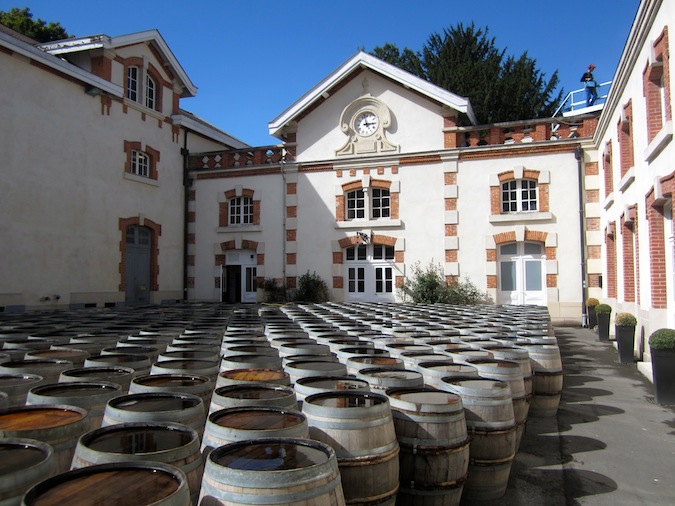 A true visionary, Joseph Krug was obsessed with the exceptional. He was uncompromising in his approach to Champagne and as a result, Krug was the first house in which each and every cuvée was designed to be of equal quality and distinction; there was no hierarchy.Krug's goal was to provide his clients with the most pleasurable Champagne experience possible every year, regardless of climate. To accomplish this feat, Krug took Champagne blending beyond anything customary at the time and in the Krug paradigm the uniqueness of each vineyard plot is preserved and exalted.Time also played a key factor, from the time it took the trees to grow for the French oak barrels, to the length of time allowed for the base wines to age before being blended in a cuvée. Joseph Krug firmly believed you could not make a superior product without superior ingredients and used only the finest materials, grapes, and methods to craft his legendary sparkling wines.
A true visionary, Joseph Krug was obsessed with the exceptional. He was uncompromising in his approach to Champagne and as a result, Krug was the first house in which each and every cuvée was designed to be of equal quality and distinction; there was no hierarchy.Krug's goal was to provide his clients with the most pleasurable Champagne experience possible every year, regardless of climate. To accomplish this feat, Krug took Champagne blending beyond anything customary at the time and in the Krug paradigm the uniqueness of each vineyard plot is preserved and exalted.Time also played a key factor, from the time it took the trees to grow for the French oak barrels, to the length of time allowed for the base wines to age before being blended in a cuvée. Joseph Krug firmly believed you could not make a superior product without superior ingredients and used only the finest materials, grapes, and methods to craft his legendary sparkling wines.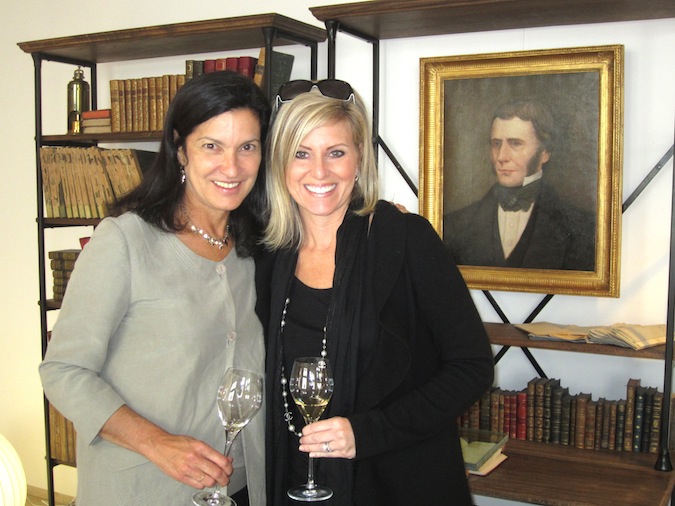 Krug recorded detailed notes of his meticulous methods and the founding principles of the house in a cherry red, leather bound notebook to be passed down to his family. After Krug's death in 1861, however, the notebook was placed in a safe deposit box and not discovered again until 2010 when newly appointed President and CEO of Krug, Margareth "Maggie" Henriquez (pictured above), was searching for information about the historical basis for the house's standards.The contents of the red leather notebook, now on display at Krug headquarters in Reims, and reading about the history of the house in Joseph Krug's own words, helped Henriquez understand this exceptional house like no other source could. Today her mission is to disseminate this information to the world and Henriquez' inherent grace, charm, and extensive business experience make her the perfect messenger of this compelling history.
Krug recorded detailed notes of his meticulous methods and the founding principles of the house in a cherry red, leather bound notebook to be passed down to his family. After Krug's death in 1861, however, the notebook was placed in a safe deposit box and not discovered again until 2010 when newly appointed President and CEO of Krug, Margareth "Maggie" Henriquez (pictured above), was searching for information about the historical basis for the house's standards.The contents of the red leather notebook, now on display at Krug headquarters in Reims, and reading about the history of the house in Joseph Krug's own words, helped Henriquez understand this exceptional house like no other source could. Today her mission is to disseminate this information to the world and Henriquez' inherent grace, charm, and extensive business experience make her the perfect messenger of this compelling history.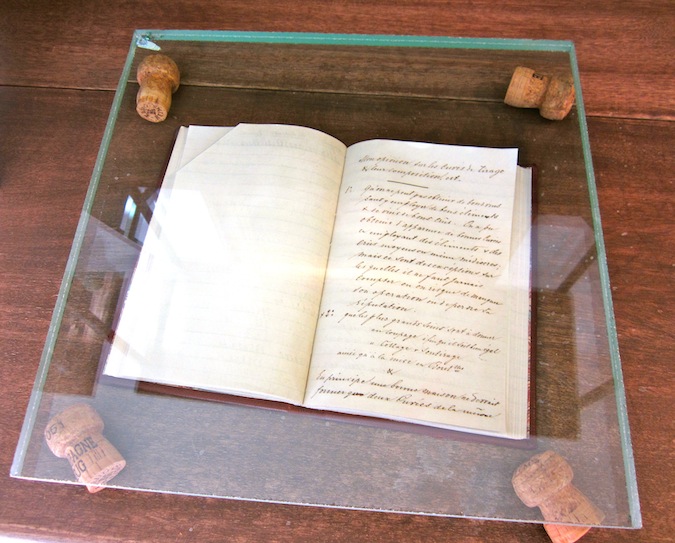 Needless to say, it was an honor to visit this distinguished Champagne House. We arrived for our Krug visit on a sunny day in Reims after a 45-minute train ride from Paris and were greeted with glasses of Grande Cuvée and ushered into the library of Krug's headquarters on Rue Coquebert.On our way into the library we passed a glamorous Pinel & Pinel Krug Picnic Trunk. Only thirty of these rare pieces were made and each features the essentials of any Krug-inspired picnic: a small table, two folding chairs, Champagne flutes, truffle shaver, and mother of pearl caviar spoons!On the far wall of the library, a portrait of Joseph Krug was displayed above his cherished, cherry red notebook (see photo above). Maggie soon emerged and greeted us warmly, kindly asking about our travels. Before long we were making the descent into the chalk caves, the resting place of all of Krug's cuvées as well as their reserve base wines.
Needless to say, it was an honor to visit this distinguished Champagne House. We arrived for our Krug visit on a sunny day in Reims after a 45-minute train ride from Paris and were greeted with glasses of Grande Cuvée and ushered into the library of Krug's headquarters on Rue Coquebert.On our way into the library we passed a glamorous Pinel & Pinel Krug Picnic Trunk. Only thirty of these rare pieces were made and each features the essentials of any Krug-inspired picnic: a small table, two folding chairs, Champagne flutes, truffle shaver, and mother of pearl caviar spoons!On the far wall of the library, a portrait of Joseph Krug was displayed above his cherished, cherry red notebook (see photo above). Maggie soon emerged and greeted us warmly, kindly asking about our travels. Before long we were making the descent into the chalk caves, the resting place of all of Krug's cuvées as well as their reserve base wines.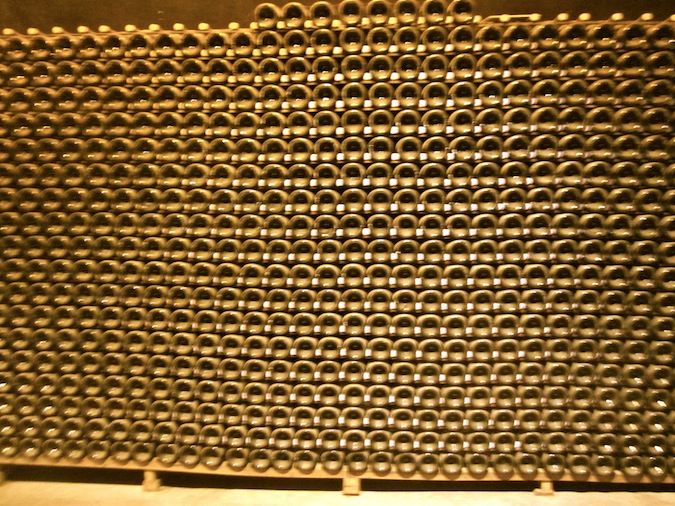
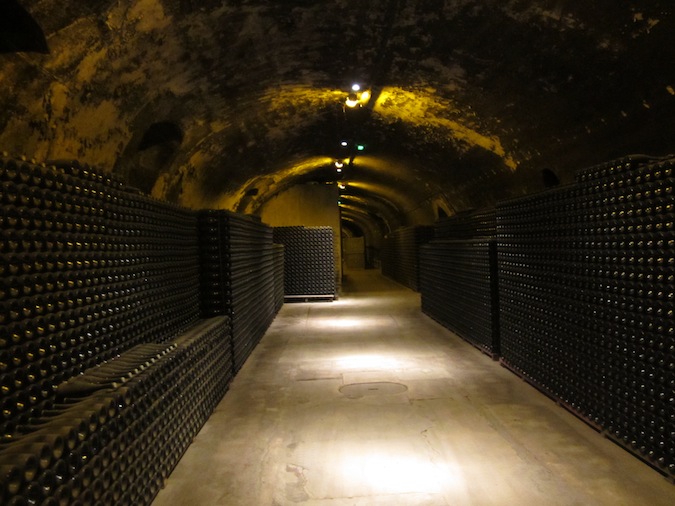
 As our eyes adjusted to the dimly lit caves, we could see rows of riddling racks and massive stacks of Champagne bottles nestled in alcoves off the main hallway. While attempting to calculate how many bottles I could drink if left in the caves overnight, we encountered the Krug riddlers (pictured below). These two gentlemen are responsible for "riddling" the Champagne bottles which involves turning each bottle by hand in order to loosen the sediment which occurs as a byproduct of secondary fermentation.Their ultimate goal is to coax the sediment, or "lees," into the neck of the bottle where it can later be disgorged (for more about riddling, click here). The riddlers were hard at work but took the time to allow us to try our hand at the process. After attempting it ourselves it sure made us appreciate the dexterity it takes to riddle 7,000 bottles and hour! To see a video of one of the Krug riddlers in action, please click here.
As our eyes adjusted to the dimly lit caves, we could see rows of riddling racks and massive stacks of Champagne bottles nestled in alcoves off the main hallway. While attempting to calculate how many bottles I could drink if left in the caves overnight, we encountered the Krug riddlers (pictured below). These two gentlemen are responsible for "riddling" the Champagne bottles which involves turning each bottle by hand in order to loosen the sediment which occurs as a byproduct of secondary fermentation.Their ultimate goal is to coax the sediment, or "lees," into the neck of the bottle where it can later be disgorged (for more about riddling, click here). The riddlers were hard at work but took the time to allow us to try our hand at the process. After attempting it ourselves it sure made us appreciate the dexterity it takes to riddle 7,000 bottles and hour! To see a video of one of the Krug riddlers in action, please click here.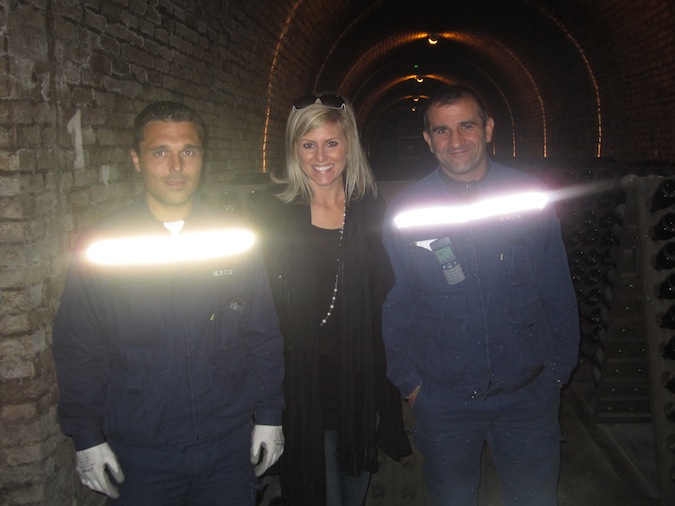 After our riddling lesson we wound our way around to the home of Krug's extensive collection of reserve wines. Ensconced in a securely locked area of the cave were rows of tanks containing the precious wines. A chalk board on the front of each tank indicated the vintage and vineyard parcel since each are fermented separately.Close by was a library containing Krug Champagne dating back to the 1880's. Some bottles were resting on their sides while others were stored sur pointe, upside down, just begging to be disgorged - at least that's what I envisioned them saying to me! Prominently displayed in this library was a quote from French writer André Malraux which, translated to English, read, "There are works that pass the time, and others that explain time." I think Joseph Krug would have appreciated the remark.
After our riddling lesson we wound our way around to the home of Krug's extensive collection of reserve wines. Ensconced in a securely locked area of the cave were rows of tanks containing the precious wines. A chalk board on the front of each tank indicated the vintage and vineyard parcel since each are fermented separately.Close by was a library containing Krug Champagne dating back to the 1880's. Some bottles were resting on their sides while others were stored sur pointe, upside down, just begging to be disgorged - at least that's what I envisioned them saying to me! Prominently displayed in this library was a quote from French writer André Malraux which, translated to English, read, "There are works that pass the time, and others that explain time." I think Joseph Krug would have appreciated the remark.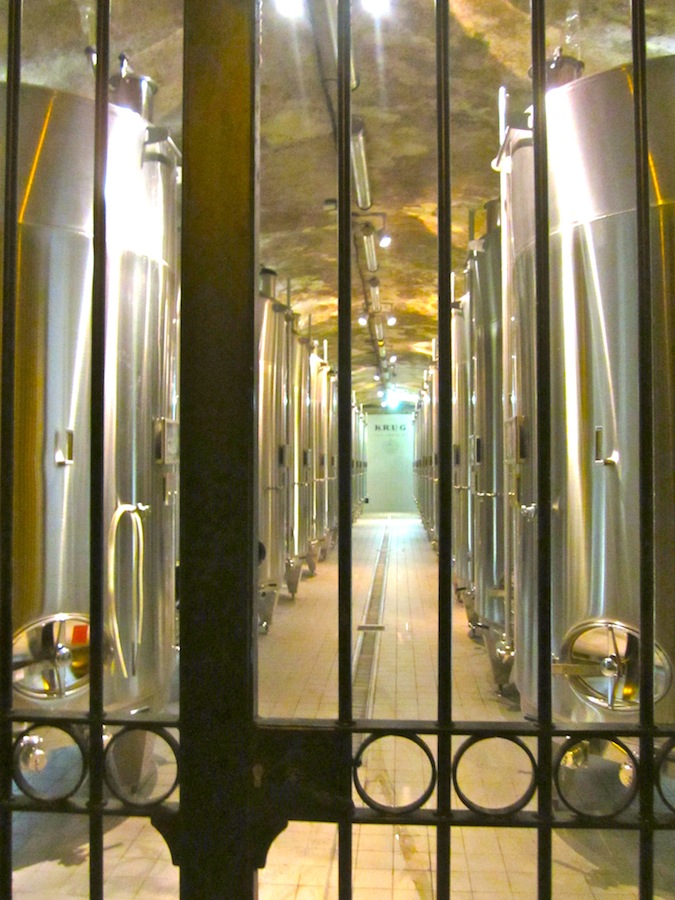

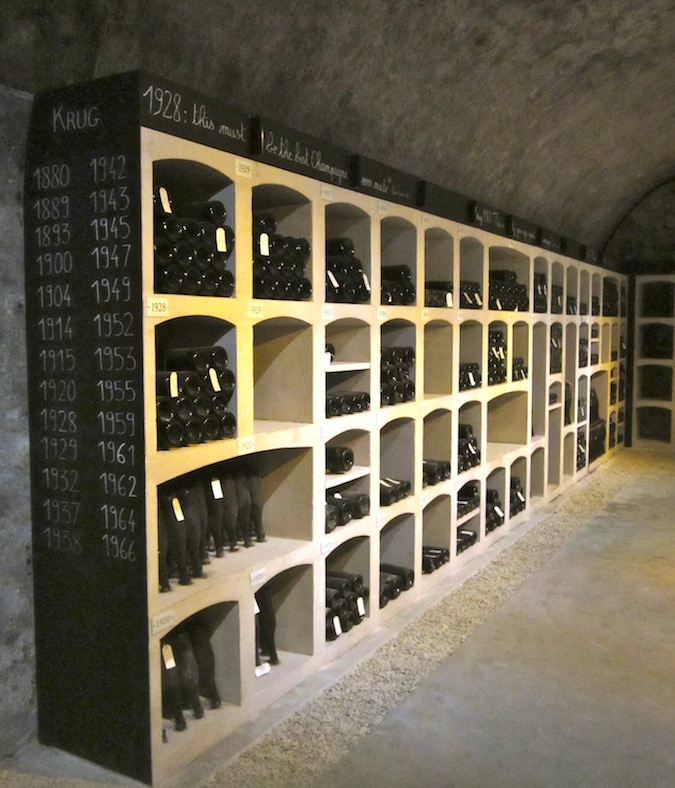 After our tour of the caves we were ready to savor a selection of Krug's glorious cuvées. The Krug Grand Cuvée is the flagship wine of the house and the embodiment of Joseph Krug's dedication to excellence. This multi-vintage offering draws from approximately 120 base wines from 10 or more vintages, some of which may have aged for up to 15 years.It is the complex blending process which helps create the wine's hallmark richness, depth, and remarkable elegance. Once blended, the wine spends an additional six years in the Krug cellars resulting in heady aromas of toasted brioche, hazelnut, and spice. The palate rewards with a rich, yet elegant mouthfeel rife with flavors of citrus peel, white flowers, baked apple, honey and spice with a long, persistent finish.
After our tour of the caves we were ready to savor a selection of Krug's glorious cuvées. The Krug Grand Cuvée is the flagship wine of the house and the embodiment of Joseph Krug's dedication to excellence. This multi-vintage offering draws from approximately 120 base wines from 10 or more vintages, some of which may have aged for up to 15 years.It is the complex blending process which helps create the wine's hallmark richness, depth, and remarkable elegance. Once blended, the wine spends an additional six years in the Krug cellars resulting in heady aromas of toasted brioche, hazelnut, and spice. The palate rewards with a rich, yet elegant mouthfeel rife with flavors of citrus peel, white flowers, baked apple, honey and spice with a long, persistent finish.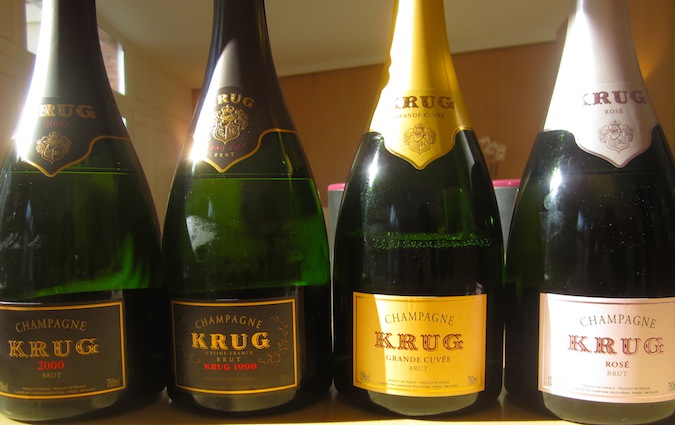 Next, we enjoyed the delightful Krug Brut Rosé, a blend of the three classic grape varieties of Champagne: Chardonnay, Pinot Noir, and Pinot Meunier. It is made using wines from a wide range of vintages which are then blended with skin-fermented Pinot Noir which imparts the wine's hallmark color and spice. On the nose, expressive aromas of red berries, freshly baked pastry, and spice are followed on the palate by notes of wild strawberry tart, black raspberry, candied citrus peel, anise, and a whiff of smoke. The acid structure prevents the wine from seeming heavy at all, making it the lesson in elegance that it is.Contrary to the concept of the Grand Cuvée which creates an exceptional wine regardless of the year, Krug's vintage offerings express only years with character and a special story to tell. Vintage wines also remain in the Reims cellars for an additional ten years or more to enhance their expression and elegance, again reinforcing the element of time and its enduring importance to the house. We had the pleasure of enjoying the Krug Brut 1998, a luxurious and rich, yet supremely balanced wine. A delightful mix of citrus, white flowers, apricot, honey, and toasted almond were set against an elegant frame and followed by a lingering, multi-layered finish.Next was the Krug Brut 2000 which displayed rich aromas of citrus, spice, and honeycomb. Sublime notes of brioche, hazelnut, poached pear and gingerbread graced the palate, along with refined yet subtle texture and complexity. The depth of this wine's structure was indicative of tremendous aging potential.
Next, we enjoyed the delightful Krug Brut Rosé, a blend of the three classic grape varieties of Champagne: Chardonnay, Pinot Noir, and Pinot Meunier. It is made using wines from a wide range of vintages which are then blended with skin-fermented Pinot Noir which imparts the wine's hallmark color and spice. On the nose, expressive aromas of red berries, freshly baked pastry, and spice are followed on the palate by notes of wild strawberry tart, black raspberry, candied citrus peel, anise, and a whiff of smoke. The acid structure prevents the wine from seeming heavy at all, making it the lesson in elegance that it is.Contrary to the concept of the Grand Cuvée which creates an exceptional wine regardless of the year, Krug's vintage offerings express only years with character and a special story to tell. Vintage wines also remain in the Reims cellars for an additional ten years or more to enhance their expression and elegance, again reinforcing the element of time and its enduring importance to the house. We had the pleasure of enjoying the Krug Brut 1998, a luxurious and rich, yet supremely balanced wine. A delightful mix of citrus, white flowers, apricot, honey, and toasted almond were set against an elegant frame and followed by a lingering, multi-layered finish.Next was the Krug Brut 2000 which displayed rich aromas of citrus, spice, and honeycomb. Sublime notes of brioche, hazelnut, poached pear and gingerbread graced the palate, along with refined yet subtle texture and complexity. The depth of this wine's structure was indicative of tremendous aging potential.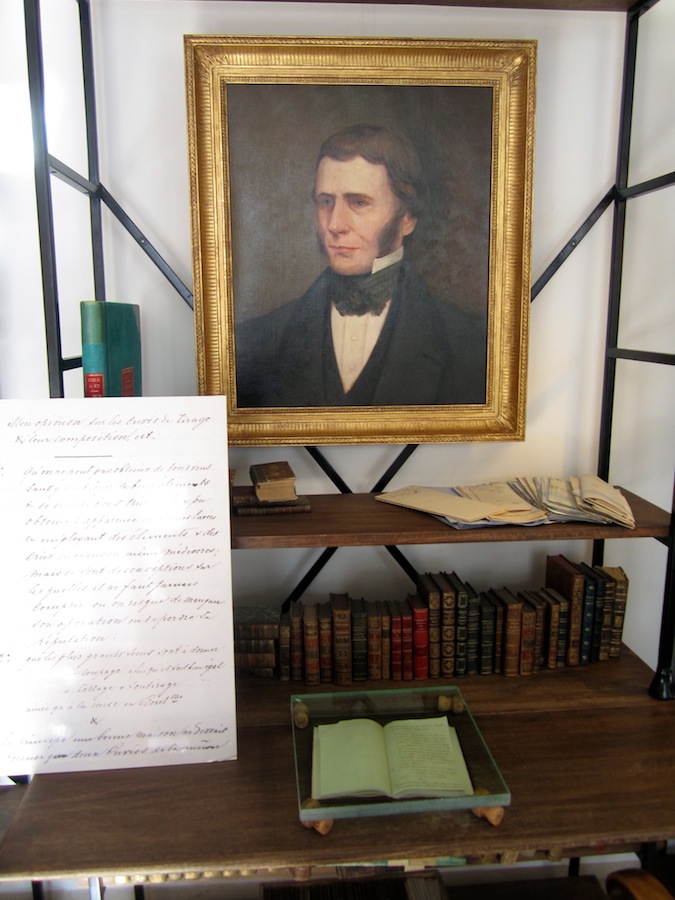 This superb tasting wrapped up our visit to Krug and I was officially able to cross an item off my bucket list. If you are interested in exploring the wines of Champagne, you owe it to yourself to sample the wines of Krug at some point in your journey. They serve as an extremely valuable reference point and reflect how unwavering attention to detail can create a truly exceptional and legendary product.Cheers,
This superb tasting wrapped up our visit to Krug and I was officially able to cross an item off my bucket list. If you are interested in exploring the wines of Champagne, you owe it to yourself to sample the wines of Krug at some point in your journey. They serve as an extremely valuable reference point and reflect how unwavering attention to detail can create a truly exceptional and legendary product.Cheers,
The Champenois have built a tradition and legacy of excellence since the days of Dom Pérignon, and Champagne Krug embodies this ethos like no other. Founded in 1843 by Joseph Krug, this iconic house surpassed traditional techniques and production standards of the time and achieved a reputation for excellence which endures to this day. A true visionary, Joseph Krug was... Read More
The post Producer Profile: A Visit to Champagne Krug! appeared first on The Glamorous Gourmet.
There are few libations on the planet that embody luxury and glamour quite like Champagne.
The Champenois have built a tradition and legacy of excellence since the days of Dom Pérignon, and Champagne Krug embodies this ethos like no other. Founded in 1843 by Joseph Krug, this iconic house surpassed traditional techniques and production standards of the time and achieved a reputation for excellence which endures to this day.
A true visionary, Joseph Krug was obsessed with the exceptional. He was uncompromising in his approach to Champagne and Krug was the first house in which each and every cuvée was designed to be of equal quality and distinction. Krug’s goal was to provide his clients with the most pleasurable Champagne experience possible each and every year, regardless of climate. To accomplish this feat, Krug took Champagne blending beyond anything customary at the time and in the Krug paradigm the uniqueness of each vineyard plot is preserved and exalted. Time also played a key factor, from the time it took the trees to grow for the French oak barrels, to the length of time allowed for the base wines to age before being blended in a cuvée. Joseph Krug firmly believed you could not make a superior product without superior ingredients and used only the finest materials, grapes, and methods to craft his legendary sparkling wines.
Krug recorded detailed notes of his meticulous methods and the founding principles of the house in a cherry red, leather bound notebook to be passed down to his family. After Krug’s death in 1861, however, the notebook was placed in a safe deposit box and not discovered again until 2010 when newly appointed President and CEO of Krug, Margareth “Maggie” Henriquez (pictured above), was searching for information about the historical basis for the house’s standards. The contents of the red leather notebook, now on display at Krug headquarters in Reims, and reading about the history of the house in Joseph Krug’s own words, helped Henriquez understand this exceptional house like no other source could. Today her mission is to disseminate this information to the world and Henriquez’ inherent grace, charm, and extensive business experience make her the perfect messenger of this compelling history.
Needless to say, it was an honor to visit this distinguished Champagne House. We arrived for our Krug visit on a sunny day in Reims after a 45-minute train ride from Paris and were greeted with glasses of Grande Cuvée and ushered into the library of Krug’s headquarters on Rue Coquebert. On our way into the library we passed a glamorous Pinel & Pinel Krug Picnic Trunk. Only thirty of these rare pieces were made and each features the essentials of any Krug-inspired picnic: a small table, two folding chairs, Champagne flutes, truffle shaver, and mother of pearl caviar spoons! On the far wall of the library, a portrait of Joseph Krug was displayed above his cherished, cherry red notebook (see photo above). Maggie soon emerged and greeted us warmly, kindly asking about our travels. Before long we were making the descent into the chalk caves, the resting place of all of Krug’s cuvées as well as their reserve base wines.
As our eyes adjusted to the dimly lit caves, we could see rows of riddling racks and massive stacks of Champagne bottles nestled in alcoves off the main hallway. While attempting to calculate how many bottles I could drink if left in the caves overnight, we encountered the Krug riddlers (pictured below). These two gentlemen are responsible for “riddling” the Champagne bottles which involves turning each bottle by hand in order to loosen the sediment which occurs as a byproduct of secondary fermentation. Their ultimate goal is to coax the sediment, or “lees,” into the neck of the bottle where it can later be disgorged (for more about riddling, click here). The riddlers were hard at work but took the time to allow us to try our hand at the process. After attempting it ourselves it sure made us appreciate the dexterity it takes to riddle 7,000 bottles and hour! To see a video of one of the Krug riddlers in action, please click here.
After our riddling lesson we wound our way around to the home of Krug’s extensive collection of reserve wines. Ensconced in a securely locked area of the cave were rows of tanks containing the precious wines. A chalk board on the front of each tank indicated the vintage and vineyard parcel since each are fermented separately. Close by was a library containing Krug Champagne dating back to the 1880’s. Some bottles were resting on their sides while others were stored sur pointe, upside down, just begging to be disgorged – at least that’s what I envisioned them saying to me! Prominently displayed in this library was a quote from French writer André Malraux which, translated to English, read, “There are works that pass the time, and others that explain time.” I think Joseph Krug would have appreciated the remark.
After our tour of the caves we were ready to savor a selection of Krug’s glorious cuvées. The Krug Grand Cuvée is the flagship wine of the house and the embodiment of Joseph Krug’s dedication to excellence. This multi-vintage offering draws from approximately 120 base wines from 10 or more vintages, some of which may have aged for up to 15 years. It is the complex blending process which helps create the wine’s hallmark richness, depth, and remarkable elegance. Once blended, the wine spends an additional six years in the Krug cellars resulting in heady aromas of toasted brioche, hazelnut, and spice. The palate rewards with a rich, yet elegant mouthfeel rife with flavors of citrus peel, white flowers, baked apple, honey and spice with a long, persistent finish.
Next, we enjoyed the delightful Krug Brut Rosé, a blend of the three classic grape varieties of Champagne: Chardonnay, Pinot Noir, and Pinot Meunier. It is made using wines from a wide range of vintages which are then blended with skin-fermented Pinot Noir which imparts the wine’s hallmark color and spice. On the nose, expressive aromas of red berries, freshly baked pastry, and spice are followed on the palate by notes of wild strawberry tart, black raspberry, candied citrus peel, anise, and a whiff of smoke. The acid structure prevents the wine from seeming heavy at all, making it the lesson in elegance that it is.
Contrary to the concept of the Grand Cuvée which creates an exceptional wine regardless of the year, Krug’s vintage offerings express only years with character and a special story to tell. Vintage wines also remain in the Reims cellars for an additional ten years or more to enhance their expression and elegance, again reinforcing the element of time and its enduring importance to the house. We had the pleasure of enjoying the Krug Brut 1998, a luxurious and rich, yet supremely balanced wine. A delightful mix of citrus, white flowers, apricot, honey, and toasted almond were set against an elegant frame and followed by a lingering, multi-layered finish.
Next was the Krug Brut 2000 which displayed rich aromas of citrus, spice, and honeycomb. Sublime notes of brioche, hazelnut, poached pear and gingerbread graced the palate, along with refined yet subtle texture and complexity. The depth of this wine’s structure was indicative of tremendous aging potential.
This superb tasting wrapped up our visit to Krug and I was officially able to cross an item off my bucket list. If you are interested in exploring the wines of Champagne, you owe it to yourself to sample the wines of Krug at some point in your journey. They serve as an extremely valuable reference point and reflect how unwavering attention to detail can create a truly exceptional and legendary product.
Cheers,
This time of year in South Florida we are obsessed with Stone Crabs, a delicacy only available from October 15th through May 15th. While these crustaceans can be found in waters as far north as Connecticut, the best are widely believed to come from Florida. The world famous Joe’s Stone Crab in Miami’s South Beach is the authority on these... Read More
The post Which Wines to Pair With: Florida Stone Crabs! appeared first on The Glamorous Gourmet.
This time of year in South Florida we are obsessed with Stone Crabs, a delicacy only available from October 15th through May 15th. While these crustaceans can be found in waters as far north as Connecticut, the best are widely believed to come from Florida. The world famous Joe’s Stone Crab in Miami’s South Beach is the authority on these crustaceans, also known as Menippe Mercenaria (Menippe = Greek, meaning force or courage and Mercenaria = Latin meaning something of value).
Unlike most other crabs including Maine’s Peekytoe, Chesapeake Blue, or the Pacific Dungeoness, only the claws of the stone crab are harvested and the crabs are not killed during the process. These crabs are captured in baited traps and only one claw per crab can be taken so it can still defend itself against predators. The claws make up about half the weight of the entire crab and once harvested, the pricey appendages are classified and priced according to weight – Colossal size claws can weigh up to 25 ounces or more! Once harvested, the crab is returned to the water where the claw will regenerate in approximately 12-24 months.

The stone crab gets its name from their extremely hard shells and the claws must be cracked prior to eating – an art form in and of itself! Stone crabs have a delicious, sweet flavor and their texture is somewhere between the delicacy of crab and the decadence of lobster. They are traditionally served with a mustard sauce which complements the delicious meat although many prefer to eat them plain with nothing at all. Many establishments are know for their mustard sauce and there’s some debate as to which type of sauce is the best. Some folks lean towards a spicy mustard sauce (like us!) while others tend towards sweet with the addition of some honey. Which type of mustard sauce do you prefer if any at all?
Wine pairing suggestions: In order to complement the texture and flavor of the crab as well as the tanginess of the mustard sauce, opt for wines with notes of citrus and stone fruit with a racy, cleansing acidity. Champagne, Sauvignon Blanc, Vermentino, and unoaked Chardonnay are wonderful choices to pair with Florida Stone Crabs. Here are our recommendations available at The Wine Atelier:
1.) Champagne Ayala Brut Majeur, Champagne, France, NV ($44) – a light, fresh style of Champagne which will complement the texture of the crab meat beautifully!
2.) Round Pond Estate Sauvignon Blanc Rutherford, California ($20) – notes of juicy citrus and white flowers characterize this California beauty!
3.) Banfi La Pettegola Vermentino, IGT Toscana, Italy, 2013 ($20) – light and bright with notes of green apple, apricot & grapefruit with a racy acidity!
4.) Drouhin Vaudon Chablis, Burgundy, France, 2012 ($25) – Notes of apple, citrus, and white peach characterize this mouth watering Chardonnay!
Cheers,
![]()